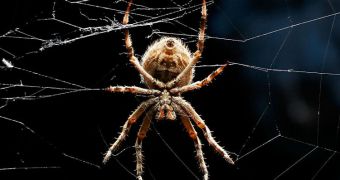Tiny hairs on the legs of spiders apparently act as individual ears, allowing the creature to feel the moves their prey makes through the air. Thus far, researchers believes that all of these hairs were acting as components for a single, large ear that was the entire exoskeleton protecting spiders.
This idea was refuted in a new investigation, which showed that the small hairs do not work together in this manner. Rather, each of them sends an individual output, which can be isolated and heard separately by the spider.
The amount of information that can be processed in this manner is a lot larger than if all hairs acted as a single ear. However, it also requires more energy and processing power to take full advantage of this evolutionary adaptation.
The fine hairs are called trichobothria, and they can be found on the legs of spiders and other insects covered by exoskeletons. Through their construction, they are able to detect air movements occurring at a scale of one ten-billionth of a meter.
This gives the spiders extreme precision in detecting the faintest motions in their environment. The scale at which these hairs are sensitive roughly corresponds to the width of an atom. “Nobody had looked at these hairs in just the right way,” researcher Brice Bathellier explains.
“When you look at what they are mechanically optimized to do, you could design better ones,” adds the expert, who is a physicist at the Institute Of Molecular Pathology, in Vienna, Austria. He is also the coauthor of a new study detailing the findings.
The work is published in the December 14 issue of the Journal of the Royal Society Interface. “[…] Nature optimizes. Animals evolve under stringent conditions,” Bathellier goes on to explain.
As such, the team was particularly interested in learning how the spiders differentiated between a gust of wind and an actual opportunity to feed. According to the team, the speed at which each of the hairs wiggles is key.
Other researches were conducted similar to hearing studies on humans, as in focused on how much the hairs were displaces. No one thought to look at how fast this was happening before. “These hairs operate at the physical limits of sensitivity across a much broader range of frequencies,” Bathellier says.
In humans, for example, there are multiple sound receptors in the inner ear, with each of them breaking down and carrying electrical impulses belonging to only a limited range of frequencies. In spiders, that range is significantly larger, Wired reports.
“They operate like band-pass filters or microphones, not like the hairs in a human ear,” Bathellier concludes.

 14 DAY TRIAL //
14 DAY TRIAL //